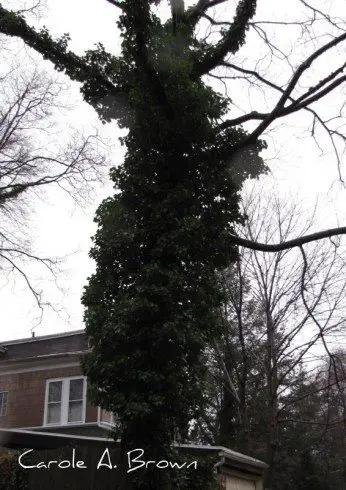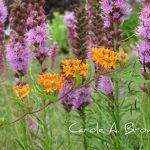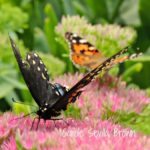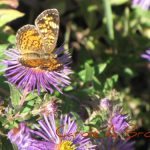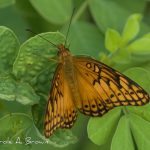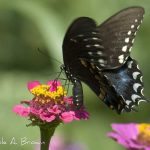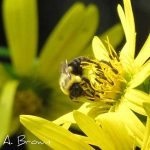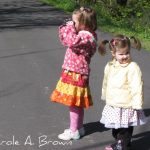I asked for your opinions last week about an article that proclaimed that invasive plants can have beneficial ecological impacts. And boy did you have opinions! Thank you for sharing them.
The article was a study of Japanese Honeysuckle in areas of Pennsylvania in October. The short version is that these researchers concluded that since Robins and Catbirds were abundant in these areas, and they eat fruit, then this plant must be good for these birds.
Some of you very astute readers noticed several huge flaws in the premise of this study and were quick to point them out, while others of you defended this position.
Later today I’m going to be interviewing Doug Tallamy about this since some nurseries have chosen to use this very limited “research” to trash his book “Bringing Nature Home” and to proclaim that this study gives them a free pass to continue to sell these plants that are wreaking havoc on natural ecosystems.
I’ll be posting that interview later this week, but before then I want to share with you all what some of you have to say about this. I appreciate your passion about the subject of invasive plants and to those of you involved in the work of ecological restoration, a huge thank you for the tireless and thankless work you do every day.
And stay tuned, because tomorrow I have some really exciting news 🙂
The main reaction to this article is very well summed up by Ursula V from Squash’s Garden:
The area around Chernobyl is a wildlife mecca. It’s got scads of species scarce elsewhere in Russia, which survive reasonably well in an area still considered unsuitable for long-term human habitation.
Therefore, nuclear accidents are good for wildlife! Everybody grab a crowbar and head for the power plant, we’re gonna save us some wildlife!
…Or, y’know, that could be a short-sighted conclusion based on observation of a limited number of species making the best of a less than optimal situation, kinda like this article.
Here are some comments from you, my dedicated and passionate readers:
Adrian Ayres Fisher at Ecological Gardening:
One of the problems with trying to conduct scientific experiments out of doors is that while the experimenters are trying to limit observed factors, the overall system is way too complex to take into account all possible influences. Therefore it is very dangerous to arrive at a generalized conclusion.
Furthermore, most conservationists that I know, both volunteer and professional, understand that a.) most landscapes are human-influenced (duh!) and b.) it is impossible to restore landscapes to “pre-settlement” conditions. That term is fraught with political implications anyway, since, of course, there were people here for thousands of years since the glaciers receded, and it’s thanks to their efforts that we have historic prairies and savannas here in Illinois. Out east, the noted travels of botanist William Bartram were not, as he thought, through a howling wilderness, but through a human-managed landscape. Those chestnut tree groves did not occur simply by accident.
Thus, the article’s argument, is something of a straw man anyway, and historically something of a reprise of the USDA offering multiflora rose whips at reduced prices to farmers and wildlife managers–good cover for and game for birds and other game, don’t you know.
Vincent Vizachero at Roland Park Native:
Having now read the original paper by Gleditsch and Carlo, my conclusion is that their research isn’t actually very interesting.
I do agree with Davis on one point, which is that more data is a good thing. However, I also think that folks like Davis (and, apparently, Gleditsch and Carlo) are working so hard to establish their skeptic “cred” that they are taking some very limited observations as the basis for (unfounded) broad conclusions.
For, example, the design of this paper was very narrowly constructed. They looked only at frugivores, only in disturbed habitat, and only in a short window of time (September/October 2009) that was purposely chosen to coincide with peak the fruiting season. In other words their study amounts to the narrowest and briefest of snapshots. These invasive-laden habitats could be the deadliest of ecological traps and the authors wouldn’t have a clue about whether that being the case.
I think this paper may serve as fuel for those people would would prefer – for whatever reason – to try to undermine the anti-invasive movement. All reasonable people will look at the research and probably dismiss it as provocative but poorly conceived and overly narrow.
Scott Hokunson at Blue Heron Landscapes
Thanks for bringing this article to our attention. This article looks solely at one part of the ecosystem (fruit eating birds), which can be troublesome. Without future projections of what the effect of rising populations in fruit eating birds will have on the ecosystem as a whole, we cannot and should not draw conclusions positive or negative. The topic of invasive species and their affect on ecosystems is being rethought in many discussions across the country/world. My first reaction to these discussions has been to recoil with worry, but I am starting to listen to the dialog and the digest the information before reacting. The final conclusion might turn out to be that we cannot reverse the invasive problem, so looking for positives may be our only answer. I do not subscribe to that view as of yet. Next week this topic will be discussed at the ELA conference in Springfield, MA. I will report back on the information shared.
Rachel at Hummingbird Way:
I have heard arguments about the potential benefits of invasives, though not this particular argument. The one I’m familiar with is the idea that invasive plants have a place in urban areas (not natural areas) because some, like Ailanthus altisimma, are able to better withstand tough city conditions like pollutants, road salt, poor soil, sidewalks growing over roots, etc. I don’t buy that argument, and I don’t buy this one, not without a lot more convincing evidence.
The article talks about fruit-eating birds, and mentions robins and catbirds. I like robins and catbirds, but are they really the birds that we should be most worried about? Just based on what I see in my own yard, these still seem to be fairly abundant. It seems to me that some of the less common neo-tropical migrants are the species of greater concern. The summary of this article mentions greater diversity of birds in the area with honeysuckle, but doesn’t mention species other than these two–I assume the original paper does(?)
The argument that holds weight with me is the one made by entomologist Doug Tallamy: that native plants are critical because they support native insects, most of which are specialists rather than generalists and will not feed on non-natives. Insects are critical because they are an important food source for a variety of birds and other animals. So…one article that talks about the value of a particular non-native plant to fruit-eating birds is not convincing to me. The business about the non-native also benefiting a native plant species via facilitation – well that probably would happen with a fruiting native plant, no?
Josh Skolnick at Trillium Native Landscapes:
Fruit-eating birds and fruiting invasive species are only one component of an ecological system. You also have to consider native insects and the birds that depend on them as well. The research data on this contradicts this other study. Invasive shrubs are very poor hosts for native insects. I can’t see how a monoculture of invasive shrubs is good for the long term for all but the few fruit eating species that benefit.
I think the conclusions of the linked article only tell half the story and omit critical data. Plus there are fruiting native shrubs that can be planted to replace the invasive species in order for the birds to benefit.
Virginia Rettig:
This seems to be a growing field. I was in VT a few months ago and came across a book that touted the virtues of invasive plants in the ecosystem (e.g., water filtration). That book seemed to ignore the habitat destruction angle altogether. I’d like to know what this honeysuckle field in Happy Valley was before it was cleared and turned into honeysuckle haven!
Katharine Patterson at Mount Cuba Center:
So strange you would mention this now, Carole. Someone just gave me a copy of “Invasive Plant Medicine: the Ecological Benefits and Healing Abilities of Invasives”, written by an herbalist and accupuncturist in VT (may be the same book, Vir…ginia!) w/ a masters in Chinese medicine. I get the healing properties but it’s hard to wrap my head around statements like “invasives perform an essential ecological function that serves to heal the land” and “restore natural balance and biodiversity to the environment..” It’s been an interesting read.
Sue Sweeney at Scalzi Riverwalk Nature Preserve:
I wonder: who is funding this sudden rash of pro-invasives studies? The one sited above shows the very common generalist birds are doing OK(but dfont they usually?) but what about the birds and other critters that depended on the now-missing native plants and their insects? Nature is way too complex for a study like this to be meaningful without a lot more factors being considered, including the method and timing of removal of the invasives.
Julie Craves, field ecologist at the University of Michigan:
This is also my area of research and although I don’t want to speak for the authors, I think we share a similar philosophy, so I’ll try to sum it up. We aren’t proponents of invasive species. But invaded areas are complex systems that need …to be understood. The bulk of research (and funding) for invasive species research goes to prevention and eradication, with much less towards how wildlife uses non-native species. If we can better understand how these systems work, we can better work to manage the preservation of ecosystem function. There are many disturbed sites in urban areas where invasives will never be eradicated. We need to know how to best evaluate them.
I completely endorse marketing, selling, and planting only natives. My perspective is working in and understanding already invaded and largely unmanaged sites. It’s kind of like you’re the doctor making sure everyone has preventative medicine and stays healthy, and I’m the oncologist!
I’d just like to also thank Carole for her indulgence with all these comments. She’s one of the few people I know who could attract such a great group of people to have this informed and civil conversation!
Ginny Stibolt, author of Sustainable Gardening for Florida:
Interesting that this comes now when Invasives Awareness week starts this Saturday. Florida has the most problems with invasives beause of our warm climate and lots of rain.
Someone wondered why people were part of the problem when it comes to the Australian pines. It’s because groups of people objected to a planned removal of these invasives, so the trees remained where they could have been removed.
Birds love the invasive Chinese tallow tree (imported by Ben Franklin to provide wax for candles). I’m not worried about the birds, but I am worried about our wooded areas.
Ellen Honeycutt:
A nursery in NC just sent out their e-newsletter with a link to this study and the comment: “Finally, if you or your friends have been jumping on the all-native plant bandwagon after reading emotion-wrenching books like Bringing Nature Home, you’ll enjoy this scientific article that cast things in a much different light. ” So I guess this nursery supports invasives …..
More From Ecosystem Gardening:
Submit your review | |

